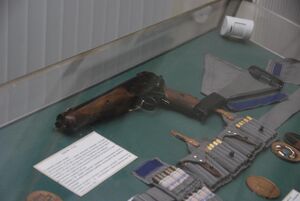Engineering:TP-82 Cosmonaut survival pistol
| TP-82 | |
|---|---|
 TP-82 in Military Historical Museum of Artillery, Engineers and Signal Corps, Saint Petersburg | |
| Type | Combination gun |
| Place of origin | Soviet Union |
| Service history | |
| In service | 1986–2006 |
| Production history | |
| Designer | Igor Aleksandrovich Skrylev |
| Specifications | |
| Mass | 2.4 kg (with stock) |
| Cartridge | 5.45×39mm (below) and 12.5×70 shotgun shells (above) |
| Barrels | 3 |
| Effective firing range | 200 meters |
| Feed system | Break-open |
| Sights | Iron |
The TP-82 (Russian: ТП-82) was a triple-barrelled Soviet pistol that was carried by cosmonauts on space missions. It was intended as a survival aid to be used after landings and before recovery in the Siberian wilderness.
Features
The pistol could be used for hunting, to defend against predators and for visible and audible distress signals. The detachable buttstock was also a machete that came with a canvas sheath.
The upper two shotgun barrels used special 12.5×70 mm ammunition (40 gauge), and the lower single rifled barrel used 5.45×39mm ammunition developed for the AK-74 assault rifle. The TP-82 had a large lever on the left side of the receiver that opens the action, and a small grip-safety under the trigger-guard that resembled a secondary trigger.[citation needed] According to NASA astronauts, the gun was highly accurate.[1]
History
The TP-82 was the result of cosmonaut Alexei Leonov's concerns after being stranded in the Siberian wilderness when his Voskhod capsule malfunctioned. He feared that the Makarov 9mm pistol that was provided in the survival kit would be ineffective against the Siberian wildlife, namely bears and wolves.[2]
TP-82s were carried regularly on Soviet and Russian space missions from 1986 to 2006.[3] They were part of the Soyuz Portable Emergency-Survival Kit (Носимый аварийный запас, Nosimyi Avariynyi Zapas, NAZ).
In 2007, the media reported that the remaining ammunition for the TP-82 had become unusable and that a regular semi-automatic pistol would be used on future missions.[4]
See also
References
- ↑ Oberg, James (2014-11-13). "How I Stopped Cosmonauts From Carrying Guns" (in en). https://spectrum.ieee.org/how-i-stop-cosmonauts-carrying-guns.
- ↑ Simpson, James (2015-02-03). "Soviet Cosmonauts Carried a Shotgun Into Space". War Is Boring. https://warisboring.com/soviet-cosmonauts-carried-a-shotgun-into-space-a9e7852c6da5.
- ↑ Pike, Travis (2022, January 19). TP-82 cosmonaut survival pistol: Russia's Space Gun. Sandboxx. https://www.sandboxx.us/blog/tp-82-cosmonaut-survival-pistol-russias-space-gun/
- ↑ "TP-82 : Russian space pistol / shotgun / carbine / flare gun no longer being carried into space" (in en-US). The Firearm Blog. 2007-10-13. http://www.thefirearmblog.com/blog/2007/10/13/tp-82-russian-space-pistol-shotgun-carbine-flare-gun-no-longer-being-carried-into-space/.
External links
- Russia has the corner on guns in space – MSNBC, Feb. 12, 2008
- TP-82 : Russian space pistol / shotgun / carbine / flare gun no longer being carried into space (with photos) – The Firearm Blog
- Soviet cosmonauts carried a shotgun into space
- The TOZ-81 'Mars' Gun Was The Soviet Union's Ultimate Space Revolver, including information on the TP-82
